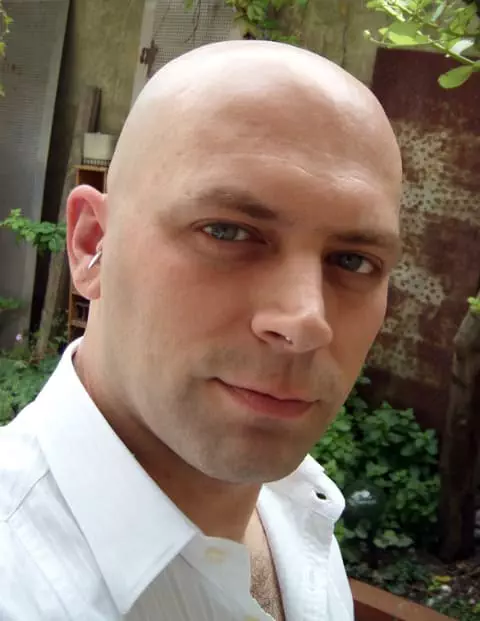
1. So Paddy, let’s ease you in gently. Tell us a little bit about yourself
Right then, amongst (too) many things I’m an Artist and I’m Curator of the Brahm Gallery in Leeds. Born and raised in Dewsbury, I currently live in London and divide my time as equally as possible between (deep breath) making my own work, programming Brahm Gallery, lecturing on artistic professional practice at universities and colleges across the UK, speaking publicly about my own work and running digital arts events at the Victoria and Albert Museum.
Oh, I also like cherry lips and floral gums, cycling, pigeons, anything ginger, cats, doom-laden science fiction, films where the stars get bumped off in the first half hour, Japanese food, and teeth that angle inwards. Combinations within the previous list are also approved of.

2. Is there such a thing as a typical day in the crazy world of Paddy Hartley?
No. The irregularity is the joy/curse of self-employment. Much of my time is spent researching and making my own work and looking for artists to exhibit at Brahm Gallery. I try and find artists who work with a craftspersons making-ethic but whose work and media are dictated by the concept or idea they are trying to communicate.
However, in my time, more unusual days have seen me:
A. Taking close up photographs of patients undergoing major facial surgery at Guys Hospital (I usually pass out having a blood test).
B. Getting naked with a bucket of mud and having 3D photos taken for an artist friend (I only fully regretted this when the work was displayed in public and featured in a movie).
C. Meeting the families of facially injured WW1 veterans who tell me the most amazing stories of how their Grandfathers coped with their injuries.
3. Project Facade and Face Corsetier are stunning explorations of concepts around beauty, disfigurement and reconstructive surgery, please tell us a bit more about your inspiration for you work.
The Face Corsetier work came about from an invitation from curators at the Victoria & Albert Museum to make and present new work in response to an event they were staging which examined attitudes towards cosmetic surgery and the beauty industry. I set myself a little hypothetical question. If it were considered taboo to surgically alter the structure the face for cosmetic purposes only, could a specially designed garment for the face alter the structure of the wearers face in the same way a corset alters the structure of the body? So I bought a sewing machine and produced a series of lip enhancing, cheek lifting, garments that I christened Face Corsets.

I intended to build into the pieces a series of commercially available facial implants which led me to form a working partnership with biomaterials scientist Dr Ian Thompson, who was making facial implants out of a material called bioglass. This resulted in a collaboration with the casting skills I’d developed at university employed to make bespoke implants for Ian’s patients who were referred for the repair of injuries such as broken cheek bones and noses. At one point, we were earmarked to make Danielle Westbrook’s septum implant, although she opted for shark cartilage instead!
Working with Ian got me to thinking more about reconstructive surgery and the origins of this particular type of surgery, and led me to the door of the Gillies Archives run by Curator Dr Andrew Bamji. In that first meeting with Andrew, and upon seeing the tiny room at the Archives filled with the 2500+ records of the 5000+ facially injured servicemen treated by surgical pioneer Sir Harold Gillies, I was compelled to get those stories out of the archives and bring them to a broader public. A common misconception is that the burned WW2 pilots, known as the Guinea Pig Club, were the real pioneers of skin-grafting at the hand of surgeon Archibald McIndoe. In actual fact it was McIndoe’s cousin Gillies who developed and pioneered many of the surgical techniques to treat the servicemen referred to him during WW1. Here was the inception of what became known as Project Façade.
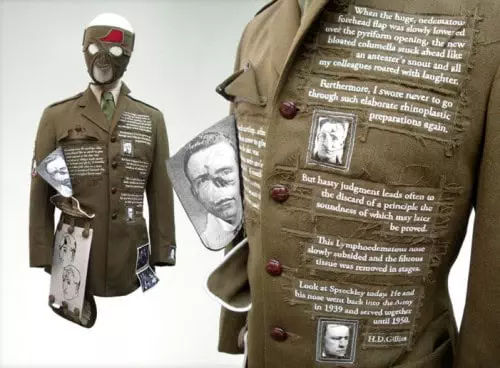
Telling the stories of a selection of the men treated by Gillies using uniforms and embroidery (after all, Gillies worked with fabric/skin and stitch) seemed a highly appropriate method to interpret the surgery they underwent and to flesh out their personal stories with information from family members I traced and information from the National Archives at Kew. Im keen that these men be remembered not for the injury and surgery they underwent, but for how they rebuilt their lives post surgery and post war. We are only too keen to commemorate the war dead, but then, as is the case now, the war injured arent even acknowledged and still appear to be actively hidden from public attention. The great thing about making the work is meeting the families of the men treated by Gillies and giving them a platform on which they can talk about them. Exhibiting the work overseas helps take their stories even further and raises awareness of the Commonwealth servicemen who were also treated at the unit Gillies set up.
4. So, your opinions on the Art world?
I have a love/hate relationship with it. At its best, good art can have a staggering emotional impact on a viewer. At its worst….well, lets not go there. Let me put it this way, too many artists and curators seem to intentionally make it as hard as possible to like or understand their work and exhibitions. Saying that, Im baffled by people who, seeing art in a gallery say ‘oooh, I like that but it wouldnt go in my living room’. It isnt supposed to hang over in your living room, its meant to be seen in a gallery. Buy a print or postcard or book of the work. You dont go to the cinema and think that youd like to take the screen, projector and film with you to view at home…you buy the smaller version (DVD). Most art is only meant to be seen in a gallery. You see art in a gallery, you see movies at the cinema. There are very few artists whose work I love. Bill Woodrow being one of them. His work is direct, intelligent and very cleverly made .
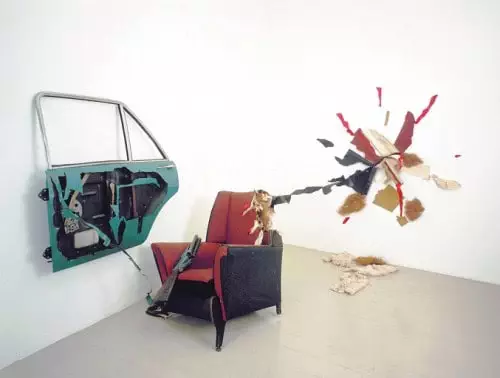
5. Who are you desperate to get your mitts on for a show at the Brahm Gallery?
Amanda Spawforth, and I got her. Brahm Gallery premieres new work from her latest series ‘What Are You Then?’ from Thursday 15th October to Tuesday 1st Dec 2009. Her work is already highly collectable just a year after graduating from Huddersfield University so bagging her is a bit of a coup.
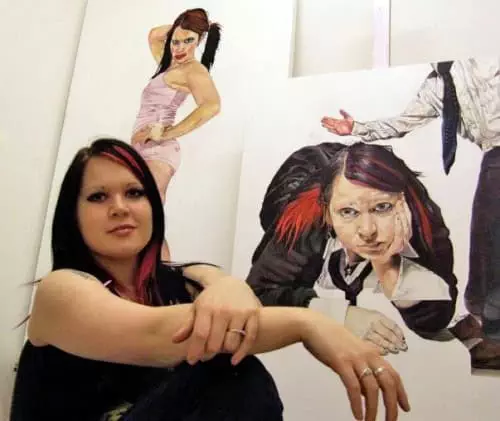
Actually, while we are on a gratuitous plug, check out our Christmas exhibition ‘Porno-Graph’ featuring 12 Artists all making work in response to various types of graph paper. The title of the exhibition has already prompted some of the artists to make work that’s already made me blush!
6. Who/what/where would you like to plug and why?
Adam and the Ants. Ok so Im 32 years late but its about time people acknowledged the genius of Mr Stuart Leslie Goddard and his later songwriting partnership with Marco Pirroni. Check Out the albums Dirk Wears White Sox and Kings of the Wild Frontier.
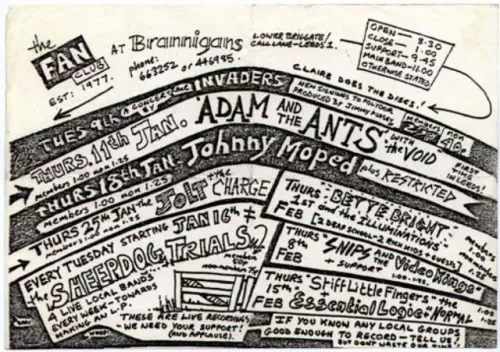
While we are on a musical thing, the 1995 album ‘Radar’ by Earthling still remains an undiscovered classic that I never tire of hearing and is by far the best of the trip hop scene of the 90’s. Check them all out on Spotify.
7. Finally if you were granted the freedom of Yorkshire what would be your first decree to brighten the lives of its inhabitants?
I’d sort out Dewsbury.
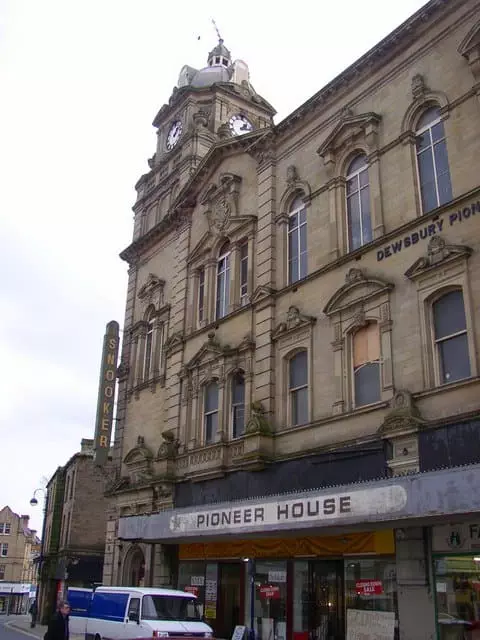
Brahm Gallery is open on weekdays from 10am – 5pm with free entry. See the Brahm Gallery website or twitter for details or email [email protected] to be added to our mailing list.
hi
i think paddy talks a lot of sense keeping his basic standards and loyalties in his younger days steady and keeping them alive in his minds eye, while looking to the future in the art world,and maintaining a great balance in the here and now great stuff paddy keep it up.
we can all learn things from past experiences sometimes (as with the disfigurements of the men in the war and their ability to cope) if we just stand still for a minute and look back and see that really we are very lucky
Best Wishes!, telemarketing leads [url=http://telemarketingleads.tumblr.com/#1]telemarketing leads[/url], jgsh,